
Sitting on the front porch on a summer day, feeling the breeze and watching the rain fall can be one of the most relaxing experiences. However, if you have allergies, it may not be quite as pleasant. Knowing how summer storms affect your allergies and what you can do to lessen the impact can help you to breathe easier.
Thunderstorm Asthma
Thunderstorm asthma is a type of attack that happens following a thunderstorm. Anyone who has asthma can experience it, but it is usually an issue for those who have seasonal allergic rhinitis during the spring and summer months.
Under normal circumstances, when it rains, there is less pollen in the air because the rain essentially acts as a cleanser. However, there is a unique sequence of events that occurs during a thunderstorm versus general rainfall. This sequence is what worsens your symptoms, and it includes:
- Mold, pollen, and other air particles concentrate when the cold downdrafts occur
- The humidity is high in the clouds, and that is where these particles go
- Lightning, wind, and humidity break these particles up to a size small enough to easily get into your sinuses, nose, and lungs
- Gusts of wind take the particles and bunch them into large amounts so that it is easy to inhale a lot at one time
The number of particles you inhale is substantially higher than on a day without thunderstorms. Even if you do not often have significant symptoms, it is possible that you will on stormy days.
Sudden temperature and humidity changes can also trigger symptoms. This can happen even if you do not have a history of allergies, and it is called non-allergic rhinitis.
You also have to consider what happens a couple of days after the storms subside. During this time, the water is aiding plant growth, which can increase the pollen counts. Mold also tends to be higher following rain since it thrives on the moisture. If you have a mold allergy, your symptoms may worsen during this time.
What Increases the Risk of Thunderstorm Symptoms?
It is estimated that approximately 65% of people who have seasonal allergies will experience thunderstorm asthma. For many of these people, the asthma attacks that they have require a trip to the emergency room. Whether you have an asthma diagnosis or not, if you have seasonal allergies, there are certain factors that can increase your risk of an attack:
- A low score on a rapid exhalation test
- Too many eosinophils (a type of blood cell associated with allergic conditions)
- A high ryegrass pollen-specific IgE (a type of antibody) level
- High exhaled nitric oxide levels (this works to measure lung inflammation)
How to Reduce Your Risk of Symptoms
If thunderstorms trigger your allergy symptoms or cause an asthma attack, it is important to avoid the outdoors during a storm. Throughout Texas, thunderstorms are common, and they can become very severe. The more severe the storm, the higher the potential to trigger significant symptoms.
You should try to stay indoors during a thunderstorm and in the couple days after to avoid the worst of it. Make sure that the air quality in your home is good so that you have a safe haven during the bad weather. You should keep the doors and windows shut so that pollen and other irritants cannot get into your home.
Another option is to use an air purifier for better indoor air quality. This helps to remove particles so that there is less in the air for you to inhale. Make sure that the filters on your HVAC system are clean, and replace them as usual to further enhance your home’s air quality.
You should take your shoes off outside when possible during the storm to keep any pollen on them outside. You should do this for the two to three days after the storm, too.
Contact Totally Cool Heating & Air today to learn more about improving the air in your home. Whether you need work on your HVAC unit, screens for your solar windows, or better insulation for your attic, we are here to help you keep your Austin, TX home comfortable in all weather. We also work on heating and cooling installations, repairs, and maintenance services.
